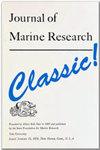Analisis Kandungan Mikroplastik pada Sedimen di Perairan Semarang, Jawa Tengah
IF 0.5
4区 地球科学
Q3 Earth and Planetary Sciences
引用次数: 0
Abstract
Kota Semarang merupakan ibukota Provinsi Jawa Tengah serta menjadi pusat bisnis, ekonomi, pendidikan, dan berbagai kegiatan sosial. Hal ini menyebabkan kota ini memiliki produksi sampah yang besar. Sampah plastik, yang merupakan salah satu jenis sampah yang sering ditemukan dapat mengalami degradasi menjadi potongan plastik lebih kecil yang dinamakan mikroplastik. Perairan Semarang dipilih sebagai lokasi penelitian karena Kota Semarang merupakan daerah dengan aktivitas manusia yang tinggi dan menghasilkan banyak limbah plastik yang dapat mengendap dalam sedimen laut. Penelitian ini dilakukan untuk mengetahui pencemaran mikroplastik pada sedimen di Perairan Semarang. Pengambilan sampel dilakukan sebanyak 4 kali yaitu pada bulan April, Mei, Agustus, dan September 2021 secara purposive sampling menggunakan alat sediment grab di tiga titik berbeda yaitu muara, pantai, dan laut. Sedimen sebanyak 50 gram direndam dalam 100 ml larutan ZnCl2 selama 24 jam. Partikel mikroplastik yang mengambang dipisahkan kemudian direndam dalam 50 ml larutan H2O2 30% selama 24 jam dan disaring dengan menggunakan kertas saring MN (Macherey Nagel). Mikroplastik yang diperoleh diamati menggunakan mikroskop dan dianalisis bentuk, warna dan kelimpahannya. Hasil penelitian menunjukkan bahwa warna dan bentuk mikroplastik yang diperoleh yaitu, berdasarkan bentuknya antara lain fragmen, pelet, film, dan fiber, berdasarkan warnanya antara lain hitam, coklat, merah, kuning, putih, hijau, dan ungu. Kelimpahan mikroplastik pada Bulan April sebanyak 2.577 partikel/kg, Bulan Mei sebanyak 2.058 partikel/kg, Bulan Agustus sebanyak 1.858 partikel/kg, dan Bulan September sebanyak 2.011 partikel/kg. Semarang City is the capital city of Central Java Province as well as being the center of business, economy, education, and various social activities. Plastic waste, which is one type of waste that is often found, can experience degradation into smaller pieces of plastic called microplastics. Semarang Waters were chosen as the research location because Semarang City is an area with high human activity and produces a lot of plastic waste which will later settle in marine sediments. This research was conducted to determine microplastic pollution in sediments in Semarang Waters. Sampling was carried out 4 times in April, May, August, and September 2021 by a purposive sampling using a sediment grab tool at three different points, namely the estuary, beach, and sea. From each sample 50 grams of sediment was immersed in 100 ml of ZnCl2 solution for 24 hours. The floating microplastic particles were separated and then immersed in 50 ml 30% H2O2 solution for 24 hours and filtered using MN (Macherey Nagel) filter paper. The obtained microplastics were observed using a microscope and analyzed for shape, color and abundance. The results showed that these are microplastics in the shape of fragments, pellets, films, and fibers, with the colors of black, brown, red, yellow, white, green, and purple. The abundance of microplastics in April was 2.577 particles kg-1, in May 2.058 particles kg-1, in August 1.858 particles kg-1, and in September 2.011 particles kg-1.精液水中精液微塑料含量的分析
三宝垄市是中爪哇省的首府,是商业、经济、教育和各种社会活动的中心。这就是为什么这个城市产生了大量的废物。塑料垃圾是最常见的垃圾类型之一,可以降解成更小的塑料片,称为微塑料。之所以选择Current Water作为研究地点,是因为Current City是一个人类活动频繁的地区,产生了大量可以吸收海洋沉积物的塑料垃圾。本研究旨在发现半半水环境中沉积物中的微塑料污染。采样进行了四次,分别是在2021年4月、5月、8月和9月,有意使用沉积物抓取工具在恶心、海滩和大海三个不同的点进行采样。将至少50克的溶液浸入100毫升ZnCl2溶液中24小时。分离漂浮的微塑料颗粒,然后将其浸入50ml 30%H2O2溶液中24小时,并使用MN(Macherey-Nagel)滤纸称重。使用显微镜监测获得的微塑料,并分析其形状、颜色和外观。研究表明,所获得的微塑料的颜色和形状基于碎片、瓷砖、薄膜和纤维,基于黑色、巧克力色、红色、黄色、白色、绿色和紫色。4月的微塑料密度为2577个颗粒/千克,5月为2058个颗粒/公斤,8月为1858个颗粒每千克,9月为2011个颗粒每公斤。三宝垄市是中爪哇省的首府,也是商业、经济、教育和各种社会活动的中心。[UNK]塑料垃圾是一种常见的垃圾,可以降解成更小的塑料片,称为微塑料。之所以选择三宝垄水域作为研究地点,是因为三宝垄市是一个人类活动频繁的地区,会产生大量塑料垃圾,这些垃圾后来会沉淀在海洋沉积物中。本研究旨在确定三宝垄水域沉积物中的微塑料污染。2021年4月、5月、8月和9月,在河口、海滩和海洋三个不同的点,使用沉积物抓取工具进行了4次有目的的采样。将每个样品的50克沉积物浸入100毫升ZnCl2溶液中24小时。分离漂浮的微塑料颗粒,然后将其浸入50ml 30%H2O2溶液中24小时,并使用MN(Macherey-Nagel)滤纸过滤。使用显微镜观察所获得的微塑料,并分析其形状、颜色和丰度。结果表明,这些是呈碎片、颗粒、薄膜和纤维形状的微塑料,颜色为黑色、棕色、红色、黄色、白色、绿色和紫色。4月份微塑料的丰度为2577个颗粒kg-1,5月份为2058个颗粒kg-1,8月份为1858个颗粒m-1,2011年9月为颗粒kg-1。
本文章由计算机程序翻译,如有差异,请以英文原文为准。
求助全文
约1分钟内获得全文
求助全文
来源期刊

Journal of Marine Research
地学-海洋学
自引率
0.00%
发文量
1
审稿时长
3 months
期刊介绍:
The Journal of Marine Research publishes peer-reviewed research articles covering a broad array of topics in physical, biological and chemical oceanography. Articles that deal with processes, as well as those that report significant observations, are welcome. In the area of biology, studies involving coupling between ecological and physical processes are preferred over those that report systematics. Authors benefit from thorough reviews of their manuscripts, where an attempt is made to maximize clarity. The time between submission and publication is kept to a minimum; there is no page charge.
 求助内容:
求助内容: 应助结果提醒方式:
应助结果提醒方式:


